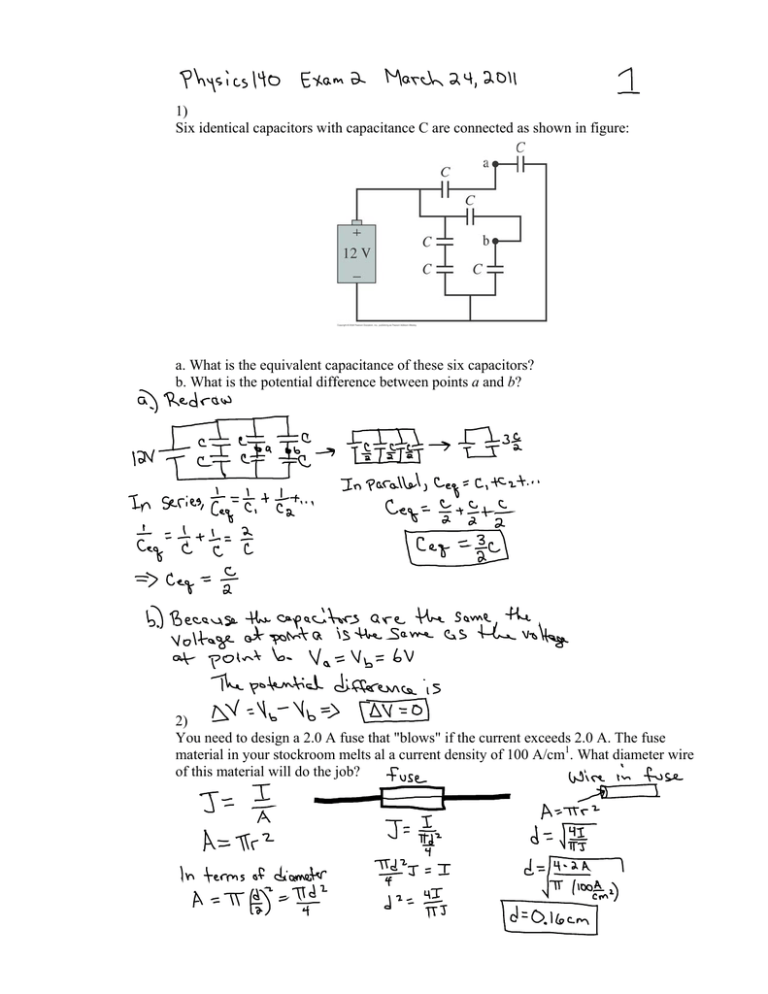1) Six identical capacitors with capacitance C are connected as
advertisement

1) Six identical capacitors with capacitance C are connected as shown in figure: a. What is the equivalent capacitance of these six capacitors? b. What is the potential difference between points a and b? 2) You need to design a 2.0 A fuse that "blows" if the current exceeds 2.0 A. The fuse material in your stockroom melts al a current density of 100 A/cm1. What diameter wire of this material will do the job? 3) For the circuit shown in the figure, find the current through and the potential difference across each resistor. Place your results in a table for ease of reading. Problem 3 con't Problem 3 con't Resistor(ohms) Current (A) Voltage (V) 0.25 6 24 4 0.56 12 0.19 5 3 0.75 1.0 2.25 2.25 3.75 3.0 4) A 12 V car battery dies not so much because its voltage drops but because chemical reactions increase its internal resistance. A good battery connected with jumper cables can both start the engine and recharge the dead battery. Consider the automotive circuit of the figure. a. How much current could the good battery alone drive through the starter motor? b. How much current is the dead battery alone able to drive through the starter motor? c. With the jumper cables attached, how much current passes through the starter motor? d. With the jumper cables attached, how much current passes through the dead battery, and in which direction? Problem 4 con't 5) The two 10-cm-long parallel wires in the figure are separated by 5.0 mm. For what value of the resistor R will the force between the two wires be 5.4 X 10-5 N? 6) The figure shows a mass spectrometer, an analytical instrument used to identify the various molecules in a sample by measuring their charge-to-mass ratio e/m. The sample is ionized, the positive ions are accelerated (starting from rest) through a potential difference ǻV, and they enter a region of uniform magnetic field. The field bends the ions into circular trajectories, but after just half a circle they either strike the wall or pass through a small opening to a detector. As the accelerating voltage is slowly increased, different ions reach the detector and are measured. Typical design values are a magnetic field strength B = 0.100 T and a spacing between the entrance and exit holes d = 10.00 cm. What accelerating potential difference ǻV is required to detect (a) N2+ (b) O2+, and (c) CO+ ? The accuracy of your answers should reflect the accuracy of the data. (For this problem, assume that all the data you need are good to six significant figures. Although N2+ and CO+ both have a nominal molecular mass of 28, they are easily distinguishable in a cyclotron). The atomic mass of 12C = 12.0000u, for 14N = 14.0031u, 16O = 15.9949u 7) The switch in the figure has been open for a long time. It is closed at t = 0 s. What is the current through the 20 ȍ resistor a. immediately after the switch is closed? b. after the switch has been closed a long time? c. immediately after the switch is reopened? Problem 7 con't 8) A very long 1.0-mm-diameter wire carries a 2.5 A current from left to right. Thin plastic insulation on the wire is positively charged with linear charge density 2.5 nC/cm. A mosquito 1.0 cm from the center of the wire would like to move in such a way as to experience an electric field but no magnetic field. How fast and which direction should she fly? Problem 8 con't



